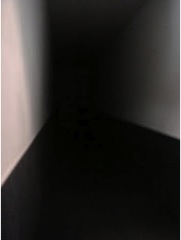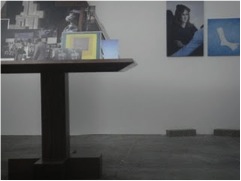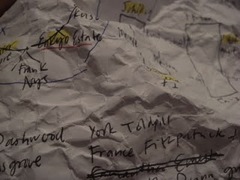You have no items in your cart. Want to get some nice things?
Go shoppingA journalist, two French exchange students, a Time Out Magazine reader and a couple are standing in the concrete yard of what looks like a depilated construction site. They’ve made an appointment to visit an art exhibition. Except, it seems, there is no exhibition. So the joke goes. Except Ryan Gander’s Locked Room Scenario isn’t a juvenile prank, but an interactive art installation.
 The address on Artangel’s website states that the installation is held at Londonnewscastle Depot on Wenlock Road, Hoxton. I actually walk past the enclosement twice before I realise that the rather desecrated-looking yard is the entrance to the ‘gallery’ – the only marking/signage available is a grey sign on the gates stating ‘Ryan Gander’s ‘Locked Room Scenario’’. No description. A harried young man sits behind a school desk in the middle of the expansive yard and scrawls my last name down on a piece of paper before directing me to the group of people huddled outside a door. This is my group, and we are to explore Gander’s mysterious installation together. Ryan Gander, according to Artangel’s website, is a British artist whose works ‘springs from jackdaw instincts for appropriation and re-presentation, and associative thought processes that connect the everyday and the esoteric, the overlooked and the commonplace.’
The address on Artangel’s website states that the installation is held at Londonnewscastle Depot on Wenlock Road, Hoxton. I actually walk past the enclosement twice before I realise that the rather desecrated-looking yard is the entrance to the ‘gallery’ – the only marking/signage available is a grey sign on the gates stating ‘Ryan Gander’s ‘Locked Room Scenario’’. No description. A harried young man sits behind a school desk in the middle of the expansive yard and scrawls my last name down on a piece of paper before directing me to the group of people huddled outside a door. This is my group, and we are to explore Gander’s mysterious installation together. Ryan Gander, according to Artangel’s website, is a British artist whose works ‘springs from jackdaw instincts for appropriation and re-presentation, and associative thought processes that connect the everyday and the esoteric, the overlooked and the commonplace.’
The two French exchange students, eager to begin, push through the doors into the inky blackness. It is midday on a Wednesday. Stumbling after them, the rest of the group follows the girls through to an eerily white corridor, reminiscent of a hospital ward. It is quiet, too, and a small area of the corridor is roped off with blue velvet. There’s a door in front of us. We go through, and I am again plunged into darkness so thick that I have to push my fingers along the walls – which are some kind of velvet or thick carpet – to feel my way through. Along the way there are two tiny boxes of light. At floor level. The first one reveals a tiny replica of an empty room and a corridor, perhaps a miniature of the exhibition itself. The second features a projector and a series of images flashing what looks like (to me) chromosome structures accompanied by phrases such as ‘Go Back. Stop.’
There’s three locked doors in this corridor. The first door is covered with newspaper. The second is simply a black locked door. Looking through the window of the third, you see a chair with a yellow Mac on it, a bin and another door that could be the exit. There’s natural sunlight coming through that exit door anyhow, which makes it all the more frustrating when you try the door and find out that it’s locked. Already I’m beginning to feel a little trapped in this ‘exhibition’, even though I’m not prone to claustrophobia.
 We exit the corridor – back to the hospital ward-esque corridor and into another large warehouse room (passing another set of locked doors on the way, which we all feel the need to try and open). The couple in our group leave us momentarily to find a bathroom. There are postcards and press releases and a timeline of artists on a montage. The room looks like it’s in the process of being set up or perhaps being taken down. Everyone feels like they may have stumbled into an ‘employee only’ room and turn to leave the room when –
We exit the corridor – back to the hospital ward-esque corridor and into another large warehouse room (passing another set of locked doors on the way, which we all feel the need to try and open). The couple in our group leave us momentarily to find a bathroom. There are postcards and press releases and a timeline of artists on a montage. The room looks like it’s in the process of being set up or perhaps being taken down. Everyone feels like they may have stumbled into an ‘employee only’ room and turn to leave the room when –
The woman next to me gasps.
“I got a text message from her this morning,” she says, pointing at one of the artist’s names on the wall. The timeline looks real – real enough – and features several artists, giving their biographies, past exhibitions, future projects etc. Except: is it real? Is it all a set up? Is this all part of Ryan Gander’s ‘Locked Room Scenario’?
The two French exchange students suddenly say that yes, they each received a text message from that woman too: ‘Rose’. They assumed it was a prank text, or a wrong number.
“What did the text say?” I ask.
“’It is this’” they reply. This makes absolutely no sense at all, but still instills a sense of eeriness into all of us. The couple returns from the bathroom.
“How did you hear about this event?” I ask each of them. The French students reveal it was word of mouth. The lady by herself read about it in Time Out magazine. The couple are actually friends of Ryan Gander.
“I read in Time Out that there might a clue in the toilet, that you can hear a conversation or something…” the lady suggests.
“Yes! I did hear something, but I thought it was someone next door.” The man in the couple says. He stays in the warehouse room to rifle through the postcards while the rest of us go to the bathroom. All together. In the same cubicle. All you can hear are murmurs and whispers, as if only one side of the conversation has been recorded. One of the French girls starts huffing, frustrated.
“I can’t hear it!” She says. “It is because we are all foreign. We have to get that English man back.”
Well, actually, I am not foreign and neither is the Time Out reader but the French girls have already gone. The whole scenario is beginning to feel like a horror film; this exhibition is dividing us all already, even though we’re strangers and don’t even know each other’s first names.
There’s one more corridor to look through, and it’s perhaps the most terrifying one. There’s a large window in this corridor that shows an exhibition room, complete with a table of books, postcards and pictures laid out on the floor, and a painting of a nude. The painting has been written over in red with the words: I WANT TO THINK SERIOUSLY ABOUT WHAT I CAN ACCOMPLISH WITH WHAT IS LEFT OF MY LIFE. The set up is vaguely reminiscent of Bret Easton Ellis’ American Psycho: the huge mod art black and white nude, the scrawled puerile letters in red (which looks like blood), the ironic and self-indulgent phrase.
There’s one more room at the end: locked doors looking into another pair of locked doors looking into a rainforest. The rainforest flickers with faux lightening and in these instances of light you begin to make out a whiteboard scrawled with indecipherable symbols. Everyone’s a little more than unsettled at this point – there’s a lingering and almost gripping sense of anticipation that’s been building up slowly.
Then a phone starts ringing.
We all look through our bags – it’s that unmistakable iPhone ringtone – but no one’s phone is actually ringing. Then someone turns around and realises it’s coming from inside the series of locked doors. There’s a phone on the floor, surrounded by other phones, and it’s ringing.
“What is that?” Someone asks, horrified. There’s a picture of a masked face with two hollow black eyes appearing on the caller ID. Oh…wait. It’s not. It’s just that generic picture of the earth on the iPhone screen. The abandoned phones around it only adds to the whole ‘hostage scene’ feel of the set-up.
‘You suspect that the most impregnable locked room might be another human being. We can only guess at what goes on inside you, the rotoscope of interior art scrolling before your mind’s eye. Some people leave more clues than others. What is the breadcrumb trail you are leaving right now? Who is the unknown detective behind you, watching, looking for the key?’ Steven Poole comments on Locked Room.
After this, everything becomes unreal. Everything we passed before is questioned: the dust on the floor, the broken light bulb, the toilet sign, and even the security room with no one in it. The scrap of paper on the floor isn’t actually rubbish – I pick it up and discover it’s a map of some sorts, cramped with squiggles and words and arrows.
 The French girls are hysterically running the place trying all the locked doors again like they’re in a Saw film. I ask the couple – who know Ryan Gander – what they think of all this, hoping they can shed some light.
The French girls are hysterically running the place trying all the locked doors again like they’re in a Saw film. I ask the couple – who know Ryan Gander – what they think of all this, hoping they can shed some light.
“I think it’s more of an anticipatory exhibition rather than one with concrete clues that can be followed up,” The man divulges. “It seems like there are lots of tiny clues hidden around the place to create a sense of uncertainty. And a lot of its mystery could be hype from previous viewers, you know, people will say ‘oh I found this’ and then the other people will wonder why they didn’t find that particular thing. It’s all about viewer engagement, really.”
Even after he’s said this though, I can’t help but look at every single little thing on the way out as if it were some kind of intrinsic clue. The abandoned Macdonald’s takeaway bag on the doorstep for instance: inconsiderate rubbish or art piece? It lingered with me for a long time after I left the gallery, even on the walk back to the tube station, when I saw three Macdonald’s cokes lined up on a council estate wall. Was this Ryan Gander’s intention?
Probably not. But I suspect that ‘A Locked Room Scenario’ intended to have this effect on its viewers: to make them question their surroundings and each other in the group. On the way out, I see a new group of people approaching the building, looking equally as perplexed as I did on my way in, consulting their Google maps.
“Is that the art exhibition in there?” One of them asks, pointing.
I pause for a second, then reply: “Maybe”. It’s the truth. Maybe the building of dark corridors, strange rubbish and locked doors was the exhibition. Or maybe the exhibition as Gander intended was something more sinister and abstract, playing on the viewer’s psychosis and drawing on their reactions to create the exhibition experience.
Artangel’s ‘Locked Room Scenario’ is running until the 23rd October. Tickets (and appointed times) can be bought here.
Ysaebelle Cheung





